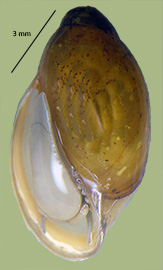Physa skinneri
> Habitat & Distribution
Physa jennessi is widespread and abundant in northern latitudes from Ontario to Alaska, becoming less common further south, through the Great Plains to Colorado, Nebraska, and Iowa (Clarke 1981, Wu 1989, Stewart 2006). Populations can inhabit a variety of shallow mesotrophic and eutrophic environments, but are especially characteristic of rich, ephemeral ponds and wetland pools (Clarke 1973, 1979, Prescott & Curtneau 2002). We have documented nine populations of P. jennessi in our Great Plains study area, primarily inhabiting marshes and grassy ponds in glaciated regions of the Dakotas.
> Ecology & Life History
Although there have been no detailed ecological studies of this rather obscure species, it seems reasonable to speculate that the general outlines of physid biology, as established from studies of better-known North American species, might apply (Dillon 2000: 66-70).
All physids seem to be preferential outcrossers, although self-fertilization is possible. Taylor & Jokinen (1984) reported that the biologically-similar Physa vernalis seems to demonstrate a simple annual (type A) life cycle in the Connecticut pond from which the species was described, adults and egg masses evident in the early spring. The pond dries in the summer, but growth is apparently quite rapid between the fall rains and the winter freeze.
> Taxonomy & Systematics
Physa jennessi was
described from ponds near Bernard Harbor, Alaska, by W. H. Dall in
1919, and was entirely unknown in the lower 48 for many
years.
Dwight Taylor described subfossil shells collected in Oklahoma,
identical in essentially all respects to those of P. jennessi, as Physa skinneri
in 1954. Subsequently Taylor’s name has been applied by some
authors to identify living populations as well. Clarke (1981)
considered skinneri
a subspecies of jennessi,
along with his own (1973) athearni,
but the morphological basis of the distinctions among any of these
three nominal subspecies has never been clear.
The penial morphology of Physa
jennessi was characterized as “type a” by George Te
(1978), bearing an entirely glandular penial sheath in the fashion of
the European Physa
fontinalis or Physa
vernalis, from the eastern United States. This
character distinguishes the fontinalis/jennessi
group from the (much more common and widespread) “type b” group of Physa gyrina and
the “type c” group of Physa
acuta.
The molecular phylogeny of Wethington & Lydeard (2007)
recapitulated Te’s a-b-c groupings based on penial morphology rather
strikingly.
> Maps and Supplementary Resources
> Essays
- The phylogenetic analysis of Wethington & Lydeard prompted me to review The Classification of the Physidae in my post of 12Oct07.
- The relationship between molecular phylogeny and reproductive isolation in the Physidae was explored in my post of 12July11, "What is a Species Tree?"
- See my post of 26Sept14 for good, comparative figures illustrating "The egg masses of freshwater pulmonate snails."
> References
Burch, J.B. 1989.
North American Freshwater Snails. Malacological Publications,
Hamburg, MI. 365 pp.
Clarke, A.H. 1973.
The freshwater molluscs of the Canadian Interior Basin. Malacologia 13:
1–509.
Clarke, A.H. 1979.
Gastropods as indicators of trophic lake stages. Nautilus 93:138-142.
Clarke, A.H. 1981. The
Freshwater Mollusks of Canada. Ottawa: The National Museums of Canada.
447 pp.
Dall, W.H. 1919.
The Mollusca of the Arctic coast of America collected by the Canadian
Arctic expedition west from Bathurst Inlet with an appended report on a
collection of Pleistocene fossil Mollusca. Report of the Canadian
Arctic Expedition, 1913-1918. Vol. 8A.
Dillon, R. T., Jr. (2000)
The Ecology of Freshwater Molluscs. Cambridge University
Press, Cambridge, England. 509 pp.
Dillon, R. T., A. R. Wethington, and C. Lydeard (2011)
The evolution of reproductive isolation in a simultaneous
hermaphrodite, the freshwater snail Physa.
BMC Evolutionary Biology 11:144. [PDF] [html]
Stewart, T.W. (2006)
The freshwater gastropods of Iowa (1821 – 1998): Species composition,
geographic distributions, and conservation concerns. American
Malac. Bull 21: 59 – 75.
Taylor, D. W. 1954.
A new Pleistocene fauna and new species of fossil snails from the high
plains. Occasional Papers of the Museum of Zoology 557: 1-16.
Taylor, D. W. &.
E. H. Jokinen 1984. A new species of
freshwater snail (Physa)
from seasonal habitats in Connecticut. Freshwater
Invertebrate Biology 3: 189-202.
Te, G. A. 1978.
The
systematics of the family Physidae (Basommatophora: Pulmonata). Ph.D.
Dissertation, University of Michigan, pp. 325.
Te, G. A. 1980.
New classification for the family Physidae (Pulmonata: Basommatophora).
Arch. Moll. 110:179-184.
Turner, A. M. &
S. L. Montgomery. 2009.
Hydroperiod, predators and the distribution of physid snails
across the freshwater habitat gradient. Freshwater Biology
54:
1189-1201.
Wethington, A. R. 2004
Phylogeny, taxonomy, and evolution of reproductive isolation in Physa
(Pulmonata: Physidae) Ph.D. dissertation, University of Alabama,
Tuscaloosa.
Wethington, A. R.
& C. Lydeard 2007.
A molecular phylogeny of Physidae (Gastropoda: Basommatophora) based on
mitochondrial DNA sequences. J. Molluscan Stud. 73: 241 - 257
[PDF] .








